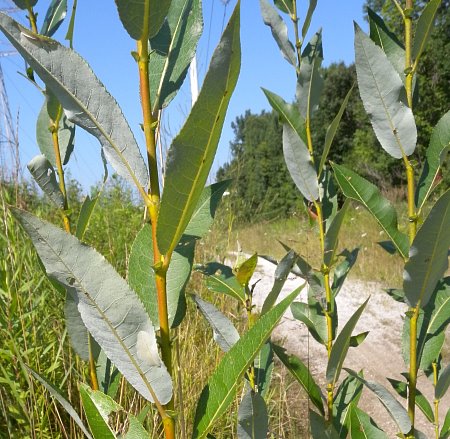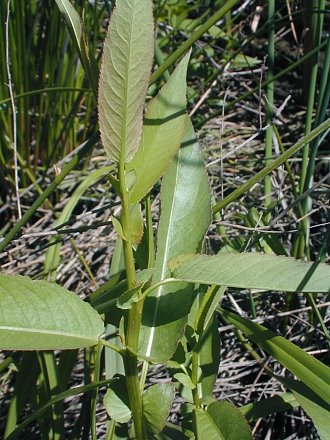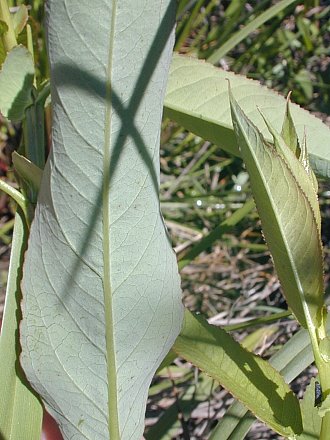
Heart-Leaved Willow is dioecious, producing staminate (male) catkins and pistillate (female) catkins on separate shrubs. These catkins are produced a little before or during the development of first-generation leaves during the spring. Staminate catkins are ¾-1½" long. Each floret of these catkins has 2 stamens. At the base of these stamens, there is a single finely hairy bract that is brown to black and a minute cylindrical gland. Pistillate catkins are 1-2½" long. Each floret of these catkins has a single lanceoloid ovary (4-6 mm. long) that is glabrous and a short style with divergent stigmata on top; there is a short pedicel underneath the ovary. Beside the pedicel, there is a single finely hairy bract that is brown to black and a minute cylindrical gland. Blooming period lasts about 1-2 weeks during the spring. Afterwards, the female florets are replaced by seed capsules that split open to release tiny cottony seeds. These seeds are distributed by the wind. The root system is shallow, woody, and branching. This shrub spreads by reseeding itself.

Cultivation: The preference is full to partial sun, wet to moist conditions, and soil containing loam, calcareous sand, or gravel. Occasional flooding is tolerated if it is temporary. The seeds remain viable for only 1-2 weeks; they require moist ground to germinate. It is also possible to propagate this shrub by sticking a broken-off stem into the ground during the spring.
Range & Habitat: The native Heart-leaved Willow is occasional throughout Illinois (see Distribution Map). Habitats include open woodlands with immature trees, soggy meadows along rivers, edges of sandy swales and sloughs, fens, and ditches. This shrub is found in both degraded and higher quality wetlands.
Faunal Associations: The nectar and pollen of the florets of Heart-leaved Willow attract many insects, especially bees and flies. These flower-visiting insects include honeybees, little carpenter bees (Ceratina spp.), cuckoo bees (Nomada spp.), mason bees (Osmia spp.), Halictid bees (including Halictid cuckoo bees), plasterer bees (Colletes spp.), Andrenid bees (Andrena spp.), Syrphid flies, dance flies (Empididae), thick-headed flies (Conopidae), Tachinid flies, Muscid flies, blow flies (Calliphoridae), dung flies (Scathophagidae), and a few wasps, sawflies, and beetles. Several species of Andrenid bees are specialist pollinators (oligoleges) of this and other willows (Salix spp.): Andrena andrenoides, Andrena bisalicis, Andrena erythrogaster, Andrena illinoiensis, Andrena mariae, and Andrena salictaria (Robertson, 1929; Krombein et al., 1979). Other insects feed destructively on the leaves, plant sap, wood, catkins, and other parts of willows. This includes the larvae of metallic wood-boring beetles, larvae of long-horned beetles, leaf beetles, weevils, larvae of leaf-mining flies, larvae of gall flies, plant bugs, stink bugs, aphids, spittlebugs, leafhoppers, armored scales, larvae of sawflies, larvae of tiger moths (Arctiidae), larvae of Geometer moths, larvae of leaf blotch miner moths (Gracillariidae), larvae of slug caterpillar moths (Limacodidae), larvae of tussock moths (Lymantriidae), larvae of midget moths (Nepticulidae), larvae of owlet moths (Noctuidae), larvae of prominent moths (Notodontidae), larvae of giant silk moths (Saturniidae), larvae of clear-winged moths (Sesiidae), larvae of Sphinx moths, larvae of Tortrix moths, and thrips. Other insects that feed on willows include the Viceroy (Limenitis archippus), Mourning Cloak (Nymphalis antiopa), Acadian Hairstreak (Satyrium acadicum), and Dreamy Duskywing (Erynnis icelus). The Insect Table provides more information about these insect feeders. Several species of birds use willows as a source of food (mostly buds & catkins). This includes such birds as the Wood Duck, Northern Pintail, White-crowned Sparrow, Common Redpoll, Evening Grosbeak, Pine Grosbeak, and Ruffed Grouse (DeGraaf, 2002; DeVore et al., 2004; Bennetts, 1900). Because these woody plants attract so many insects, they are a source of food for many insectivorous birds. Mammals that feed on willows include the American Moose and White-tailed Deer (twigs, foliage), Prairie Vole and Meadow Vole (foliage, catkins), Muskrat and Cottontail Rabbit (bark), Fox Squirrel (buds, catkins), and American Black Bear (buds, catkins, leaves); see Martin et al. (1951/1961), Hamerstrom & Blake (1939), and Romain et al. (2013). In addition, the Snapping Turtle (Chelydra serpentina) and Wood Turtle (Glyptemys insculpta) have been observed to feed on the leaves (Ernst et al., 1994; Lagler, 1943).

Photographic Location: Photographs of the sapling were taken at a ditch in Urbana, Illinois, while the photograph of a more mature shrub was taken at the Indiana Dunes National Lakeshore in NW Indiana.
Comments: Heart-Leaved Willow has an unstable taxonomic history and some authorities regard it as a variation of another species, Salix eriocephala (Missouri River Willow). Following Mohlenbrock (2002), this willow is considered a distinct species, Salix rigida. Generally, Heart-Leaved Willow differs from the Missouri River Willow by always remaining a shrub (12' or less) and having leaves that are slightly more wide. Furthermore, it often has woody stems that are yellowish tan, instead of reddish brown. Heart-Leaved Willow is also closely related to another shrubby willow, Salix glaucophylloides (Blue-Leaf Willow). Blue-Leaf Willow has leaves that are slightly more wide and more coarsely toothed than those of Heart-Leaved Willow, but these differences are not dramatic. Occasionally these and other willows hybridize, making identification even more difficult than it already is. Heart-Leaved Willow has been referred to as Salix cordata in the past, but this scientific name refers to another willow species further to the east that has much hairier stems and leaves.